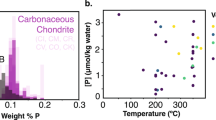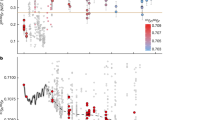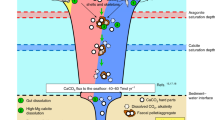Abstract
Several lines of evidence have recently reinforced the hypothesis that an ocean existed on early Mars1,2,3,4,5,6,7. Carbonates are accordingly expected to have formed from oceanic sedimentation of carbon dioxide from the ancient martian atmosphere7,8. But spectral imaging of the martian surface has revealed the presence of only a small amount of carbonate, widely distributed in the martian dust9. Here we examine the feasibility of carbonate synthesis in ancient martian oceans using aqueous equilibrium calculations. We show that partial pressures of atmospheric carbon dioxide in the range 0.8–4 bar, in the presence of up to 13.5 mM sulphate and 0.8 mM iron in sea water8, result in an acidic oceanic environment with a pH of less than 6.2. This precludes the formation of siderite, usually expected to be the first major carbonate mineral to precipitate8. We conclude that extensive interaction between an atmosphere dominated by carbon dioxide and a lasting sulphate- and iron-enriched acidic ocean on early Mars is a plausible explanation for the observed absence of carbonates.
This is a preview of subscription content, access via your institution
Access options
Subscribe to this journal
Receive 51 print issues and online access
$199.00 per year
only $3.90 per issue
Buy this article
- Purchase on Springer Link
- Instant access to full article PDF
Prices may be subject to local taxes which are calculated during checkout



Similar content being viewed by others
References
Clifford, S. M. & Parker, T. J. The evolution of the martian hydrosphere: Implications for the fate of a primordial ocean and the current state of the northern plains. Icarus 154, 40–79 (2001)
Phillips, R. J. et al. Ancient geodynamics and global-scale hydrology on Mars. Science 291, 2587–2591 (2001)
Dohm, J. M. et al. Ancient drainage basin of the Tharsis region, Mars: Potential source for outflow channel systems and putative oceans or paleolakes. J. Geophys. Res. 106, 32943–32958 (2001)
Craddock, R. A. & Howard, A. D. The case for rainfall on a warm, wet early Mars. J. Geophys. Res. 107, doi:10.1029/2001JE001505 (2002)
Fairén, A. G. et al. Episodic flood inundations of the northern plains of Mars. Icarus 165, 53–67 (2003)
Malin, M. C. & Edgett, K. S. Evidence for persistent flow and aqueous sedimentation on early Mars. Science 302, 1931–1934 (2003)
Moore, J. M. Blueberry fields for ever. Nature 428, 711–712 (2004)
Catling, D. C. A chemical model for evaporites on early Mars: Possible sedimentary tracers of the early climate and implications for exploration. J. Geophys. Res. 104, 16453–16469 (1999)
Bandfield, J. L., Glotch, T. D. & Christensen, P. R. Spectroscopic identification of carbonate minerals in the martian dust. Science 301, 1084–1087 (2003)
Carr, M. H. & Head, J. W. Oceans on Mars: An assessment of the observational evidence and possible fate. J. Geophys. Res. 108, doi:10.1029/2002JE001963 (2003)
Kirkland, L. E., Herr, K. C. & Adams, P. M. Infrared stealthy surfaces: Why TES and THEMIS may miss some substantial mineral deposits on Mars and implications for remote sensing of planetary surfaces. J. Geophys. Res. 108, doi:10.1029/2003JE002105 (2003)
Huguenin, R. L. J. The formation of goethite and hydrated clay minerals on Mars. J. Geophys. Res. 79, 3895–3905 (1974)
Mukhin, L. M., Koscheev, A. P., Dikov, Yu. P., Huth, J. & Wänke, H. Experimental simulations of the photo-decomposition of carbonates and sulphates on Mars. Nature 379, 141–143 (1996)
Clark, B. C. On the non-observability of carbonates on Mars. 5th Mars Conf. Abstr. 6214 (Lunar and Planetary Institute, Houston, Texas, 1999).
Baker, V. R. Water and the Martian landscape. Nature 412, 228–236 (2001)
Head, J. W. III, Kreslavsky, M. A. & Pratt, S. Northern lowlands of Mars: Evidence for wide-spread volcanic flooding and tectonic deformation in the Hesperian Period. J. Geophys. Res. 107, doi:10.1029/2000JE001445 (2002)
Bhattacharyya, A. & Friedman, G. M. Modern Carbonate Environments (Hutchinson Ross, Stroudsburg, Pennsylvania, 1983)
Brain, D. A. & Jakosky, B. M. Atmospheric loss since the onset of the martian geologic record: Combined role of impact erosion and sputtering. J. Geophys. Res. 103, 22689–22694 (1998)
Squyres, S. W. & Kasting, J. F. Early Mars: How warm and how wet? Science 265, 744–749 (1994)
Forget, F. & Pierrehumbert, R. T. Warming early Mars with carbon dioxide clouds that scatter infrared radiation. Science 278, 1273–1276 (1997)
Melosh, H. J. & Vickery, A. M. Impact erosion of the primordial atmosphere of Mars. Nature 338, 487–489 (1989)
Barley, M. E., Pickard, A. L. & Sylvester, P. J. Emplacement of a large igneous province as possible cause of banded iron formation 2.45 billion years ago. Nature 385, 55–58 (1997)
Russell, M. J. & Hall, A. J. The emergence of life from iron monosulphide bubbles at a submarine hydrothermal redox and pH front. J. Geol. Soc. 154, 377–402 (1997)
Holland, H. D. The oceans: A possible source of iron in iron-formations. Econ. Geol. 68, 1169–1172 (1973)
Zuber, M. T. The crust and mantle of Mars. Nature 412, 220–227 (2001)
Schaefer, M. W. Aqueous geochemistry on early Mars. Geochim. Cosmochim. Acta 57, 4619–4625 (1993)
Burns, R. G. Ferric sulfates on Mars. J. Geophys. Res. 92, 570–574 (1987)
Fernández-Remolar, D. et al. The Tinto river, an extreme acidic environment under control of iron, as an analog of the Terra Meridiani hematite site of Mars. Planet. Space Sci. 52, 239–248 (2003)
Johnson, J. W., Oelkers, E. H. & Helgeson, H. C. SUPCRT92: A software package for calculating the standard molal thermodynamic properties of minerals, gases, aqueous species, and reactions from 1 to 5000 bars and 0° to 1000 °C. (Earth Sciences Department, Lawrence Livermore Laboratory, 1991).
Bruland, K. W. in Chemical Oceanography 8 (eds Riley, J. P. & Chester, R.) 157–220 (Academic, London, 1983)
Acknowledgements
Special acknowledgements to the MER team, as their compelling evidence probing the acidity of martian palaeoenvironments was unfolded while our work was in progress, and resulted in adjustments in our model following our initial submitted draft. We also thank S. Clifford, I. Fairchild and J. Kasting for comments and suggestions that refined and focused this paper.
Author information
Authors and Affiliations
Corresponding author
Ethics declarations
Competing interests
The authors declare that they have no competing financial interests.
Rights and permissions
About this article
Cite this article
Fairén, A., Fernández-Remolar, D., Dohm, J. et al. Inhibition of carbonate synthesis in acidic oceans on early Mars. Nature 431, 423–426 (2004). https://doi.org/10.1038/nature02911
Received:
Accepted:
Issue Date:
DOI: https://doi.org/10.1038/nature02911
This article is cited by
-
Microbial growth in actual martian regolith in the form of Mars meteorite EETA79001
Communications Earth & Environment (2023)
-
An Analysis of Morphology and Diverse Mineralogy in Ius Chasma, Valles Marineris Using MCC, CRISM and CTX Data
Journal of the Indian Society of Remote Sensing (2022)
-
Terrestrial Martian Analog Heritage of Kachchh Basin, Western India
Geoheritage (2022)
-
Semiarid climate and hyposaline lake on early Mars inferred from reconstructed water chemistry at Gale
Nature Communications (2019)
-
Microbial mediated formation of Fe-carbonate minerals under extreme acidic conditions
Scientific Reports (2014)
Comments
By submitting a comment you agree to abide by our Terms and Community Guidelines. If you find something abusive or that does not comply with our terms or guidelines please flag it as inappropriate.



